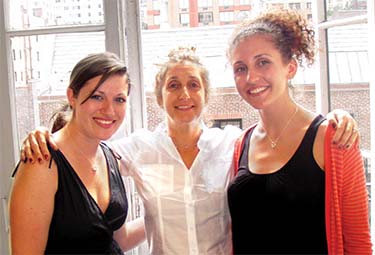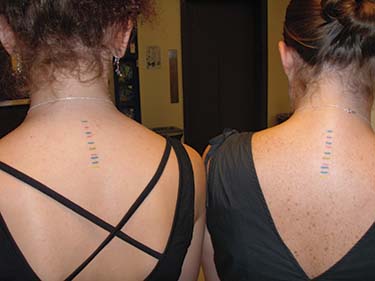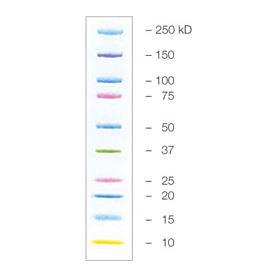Most scientists, no matter where they are at in their career, remember the moments of wonder as they navigated lab work for the first time. Whether it’s a band on a gel, a colony on a plate, or a piece of data, those first tangible results come with a feeling of having accomplished something incredible. More than ten years later, we caught up with two scientists who immortalized that feeling in the form of matching protein ladder tattoos, and discussed how their time as undergraduate researchers led them where they are today.
In 2010, Bioradiations published a story about Devin Columbus and Jessica Stevens — two recent graduates who commemorated their experience as undergrad researchers by getting matching Precision Plus Protein Kaleidoscope Prestained Protein Standards tattoos.
Why Precision Plus Ladders? As part of their research into cyclin-dependent kinase 5 (CDK5), Stevens and Columbus attempted to express the protein in bacteria and neuroblastoma cells. As they ran their first PAGE gel, checking to see whether the protein was being expressed, they watched the Precision Plus Kaleidoscope Standards separate — a beautiful, physical manifestation of the theory they had both studied. “We were kind of in awe of how cool it looked,” said Columbus.


Above, Jessica Stevens (left) and Devin Columbus (right) pose with their undergraduate research advisor, Dr. Ann Aguanno (center). Below, Columbus and Stevens show off their matching tattoos.
When the blot later confirmed that they were successful, Columbus and Stevens were elated. “You spend a lot of time in your early undergraduate science career just picturing these things,” says Stevens. “To finally be like, ‘Oh my gosh, that’s my protein?’ …It’s just a crazy tactile and exciting experience.”
When Stevens and Columbus discussed getting matching tattoos to celebrate their time in the lab, the Precision Plus Ladder was an obvious choice. In addition to encapsulating the wonder and excitement of their first successful gel, they felt the colorful ladder was a beautiful, but subtle, nod to the science they both loved.
Science Communication on the Front Lines
After graduation, Stevens went on to obtain a master’s degree from Nova Southeastern University and became certified as a physician’s assistant (PA). She currently works at a primary care facility in Florida, where she sees patients ages three and up. “I really do love it,” she says.
In addition to leading her to where she is today, Stevens says her experiences in the lab and at conferences helped develop her science communication skills, which she uses now to explain concepts to patients. This ability has become even more critical recently.
“The pandemic has really made it clear that there’s somewhat of a deficit of basic science understanding,” Stevens says. “There have been times where I’m writing out DNA to RNA to protein on the paper on my exam table. You know… ‘Let’s talk about the vaccine. Let’s talk about how it doesn’t enter the nucleus.'”
From PAGE to Clinical Research
Columbus’ career led her to City University of New York, Hunter College, where she earned her Master’s degree in Biological Sciences. She credits her time in the lab as an undergrad with giving her a jump start in grad school. “When I had to run a PCR on day one,” she says, “I knew what I was doing. I knew why I was doing it.”
After several years working in research, Columbus transitioned into clinical research, and is now a program manager for an international tuberculosis study. “My background in basic science informs everything that I do, even though I’m not sitting at a bench,” says Columbus. “I think that gives me a real edge.”
Wherever her career takes her, Columbus declares, “I never want to get away from basic science… It’s what I love, even though I’m not necessarily looking to be a PI [principal investigator] or to be executing experiments on a daily basis.”
Set for Success
Although Columbus and Stevens are not currently working in labs, they both agree that their experience as undergraduate researchers, and in particular, at a small, undergraduate-only institution, has been a key factor in getting them where they are today. Whether participating in a deep discussion about epigenetics in a class of only a few students or working directly with their PI to design and carry out experiments in the lab, they credit many of their opportunities to attending a small university.

Visit our website to learn more about the Precision Plus Protein Kaleidoscope Prestained Protein Standards.
But do Stevens and Columbus still have their matching Precision Plus Ladder tattoos? Of course! “I love my tattoo,” laughs Stevens. She even has plans to expand it into a full gel, highlighting the proteins that have been influential in her life. “Obviously CDK5 will be one of them, and… I’m thinking about getting a SARS-CoV-2 spike protein.”
Get Inked (Temporarily)
Want to try out a colorful protein ladder tattoo, without the commitment? While supplies last, sign up to receive a free pack of Precision Plus Protein Kaleidoscope Ladder temporary tattoos.

